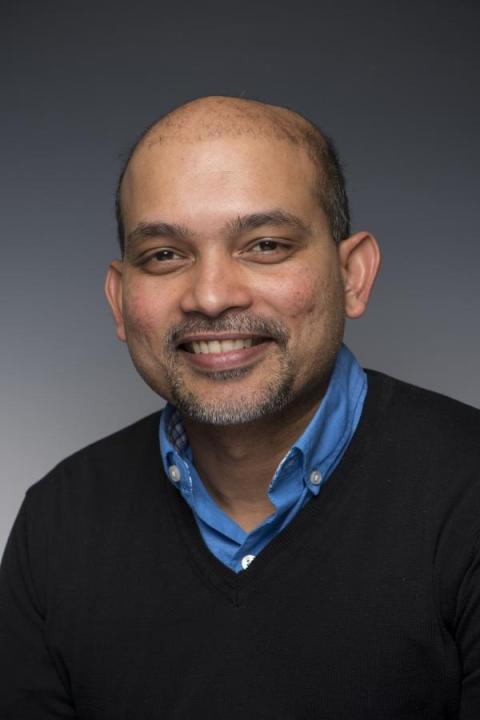
As a high schooler, Dr. Arthanat’s career aspirations shifted dramatically after his grandfather suffered a massive stroke. Facing a gap in rehabilitative services, Sajay became the daily care provider for a partially paralyzed adult no longer able to speak or independently perform daily activities. Using a trial-and-error approach, he developed his own methods to manage his grandfather’s personal needs during an experience that blossomed into a career in occupational therapy.
After earning a bachelor’s degree in Occupational Therapy from the Santosh College of Dr. M.G.R University, Arthanat worked as an occupational therapist in India with the Raksha Institute for Children with Multiple Handicaps and with St. Johns’ Medical College and Hospital. In pursuit of additional training, he moved from the warm climate of southern India to the snowbelt in upstate New York to earn an Advanced Certificate in Assistive Technology and a Ph.D. in Rehabilitative Science from the University of Buffalo.
During six years in Buffalo, Arthanat worked as a course designer, co-instructor, and researcher with the university’s Department of Rehabilitation Science and Rehabilitation Engineering Research Center on Technology Transfer. In 2007, he accepted a full-time faculty position with the Occupational Therapy Department at UNH. Building on years of teaching, advising, grant writing and research, Sajay became the Program Director for the online Assistive Technology Graduate Certificate in 2021.
Having developed and taught assistive technology courses for fifteen years, Dr. Arthanat complements his educator role with research on technology applications across the lifespan. His work with seniors has recently culminated in a grant from the National Institute on Aging to fund the development and testing of social assistive robots in the home setting, specifically for Alzheimer’s patients. The purpose of these robots is to track preprogrammed critical activities - such as missed medications - and report problems to a human caregiver.
"Caring for aging adults, especially those dealing with progressive Alzheimer’s and dementia, can place a high burden on family caregivers. The ultimate goal of this research is to help support these caregivers while keeping their family member healthy and active at home."
To properly align client needs with the right assistive device, Arthanat places a high value on analytical data. His topic of his dissertation was measuring device usability, geared to creating professional guidelines based on efficacity, adoption rate and cost. He points out that insurance coverage can be predicated on evidence-based data and that, ideally, manufacturers should review external research to steer their technology development.
“Simply assigning a technology is not enough,” says Sajay. Adapting to a new device poses psychosocial challenges and technology acceptance is overwhelmingly dictated by the individual’s outlook of their condition. To foster a positive direction, occupational therapists must understand the client’s physical and cognitive condition, age, social outlook and emotional landscape.
"The neurons of the brain often need time to adapt so a therapist must evaluate whether a particular technology will help the client attain their best outcome. As their condition and context evolve, assistive devices are designed to close the gap with their abilities. Even low-tech devices can break through the barrier of isolation and initiate the process of achieving greater self-sufficiency and social health."
In the case of children with disabilities, Sajay explains that a delay in therapy can seriously impact their social, emotional, and intellectual development. Conversely, studies show a steep rise in neuroplasticity as the brain quickly responds and adapts to incoming information from a new device. He states that occupational therapy is a highly interdisciplinary field that requires a context-based approach in addressing a child’s needs within their various environments: home, school, daycare, and playground. According to Arthanat “matching the body’s systems with technology requires patience and gentle persistence but successful adaptation can transform a child’s life.”
To capture the mathematics of productivity, in a study on employed adults with disabilities, Sajay evaluated the cost of assistive technology vs. income ratio and the conclusion was unmistakable. People with disabilities earning a salary make a positive contribution to society by paying income taxes. In addition, they use less health resources, experience fewer mental health problems, need minimal public health services and are less likely to become institutionalized. Analysis showed that the lifelong cost of assistive technology devices for this population is dwarfed by their measurable productivity. Says Arthanat, “Removing the obstacles of cost and access to technology for people with disabilities is offset many times over by a positive economic return.”
Delighted by the opportunity to manage the online UNH Assistive Technology program, Sajay is percolating with ideas for improvement and expansion such as simplifying the requirements and using active clinicians with a range of expertise during the coursework. While most AT program students have a background in occupational or physical therapy, education, social work and nursing, he wants to attract more engineering students to see technology from the client’s perspective and encourage them to take steps toward a more universal design.
"Many working professionals prefer online coursework because of its easy access, flexibility with their personal schedules and the freedom to log in at a time and place of their choosing. Our instructors develop learning modules in small chunks; students can “pause and play” to learn and absorb the materials at their own pace. Communication and interaction foster a successful learning environment with a healthy atmosphere for professional exchange."
The early passion and commitment of a caregiver encompasses colleagues and students and Sajay cherishes the milestones of their growth and success. However, his broader goal is to empower people to overcome their barriers to greater independence.
Written by Gwendolyn Goguelet